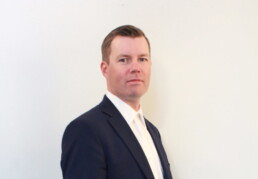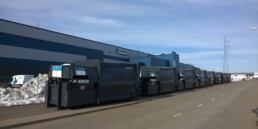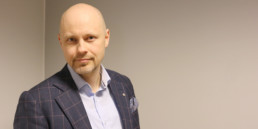Smart waste management – digitalizing the entire chain
In this series of articles, we present the experts behind the Europress SMART system and share their thoughts regarding how smart waste management is changing the operating environment of the circular economy.
In the fifth and last article in this series, we look to the future as Europress IT Development Manager Tommi Häkkinen reveals the next step along the road to digitalization.
“The change within the waste management sector is just beginning and will be just as significant as it has already been in other fields of logistics. All the conditions for this already exist,” says Häkkinen.
The pressure for change is being created by regulatory requirements, stricter environmental standards and rising costs. Another challenge is that currently much of the value of materials is lost during the recycling process.
“There is a need for more accurate visibility concerning the proportions of raw material produced, recycled and disposed of. The prices of virgin raw materials will rise and demand for recycled raw materials will increase,” Häkkinen believes.

There is a lot of data – now it should be fully harnessed.
However, according to Häkkinen, the waste management sector has huge potential for meeting these challenges simply by streamlining current operating models.
“Based on the data we collect, we see that where SMART is not fully utilized, there is still much room for improvement in how the devices are used. In other words, technological advances are ahead of established practices, so now it should be possible to take advantage of these opportunities,” Häkkinen adds.
Product development at Europress is both directly and indirectly driven by major megatrends such as climate change, technology and responsibility. The goal is to improve competitiveness and the customer experience in a changing environment, as well as to increase the efficiency of recycling. Above all, it is a question of how material flows as a whole can be managed efficiently and smoothly in order to achieve the maximum benefit for the customer, the environment and the operator.
“It means that we need to be able to create new solutions that help our partners and customers ensure that recycling is handled efficiently. In practice, this can only be achieved by digitizing the entire chain from the place of creation to processing and disposal,” Häkkinen says.
Customers expect care-free and easy waste management. Europress solutions focus on minimizing the work for users and taking care of everything automatically.
“We strive to respond to customer needs precisely and with a multi-channel approach. We have designed our mobile user interface to provide all the information and functions that the user needs to operate the device. The SMART portal provides visibility to the customer’s entire fleet of equipment and how efficiently it is being operated,” Häkkinen explains.
Smart features are included in all Europress products and services, so they are available as part of any solution we deliver – whether it involves a demanding industry with its own automation systems or a single waste container in a small grocery store. The goal is to remain at the forefront of device technology.
We need to be able to create new solutions that help our partners and customers ensure that recycling is handled efficiently.
In practice, this can only be achieved by digitizing the entire chain from the place of creation to processing and disposal.
“We want to understand the needs of our customers and partners and develop the best solutions for them. We believe that data and integrations are a prerequisite for taking the next step. We swear in the name of flexibility, and we understand that the same models are not suitable for everyone. That is why we have organized our development team to be as agile as possible,” Häkkinen says, describing the starting points for all development work at Europress.
The development trend is towards increasingly advanced automation. In the future, logistics and processing facilities will be increasingly integrated. Transport and processing will be coordinated autonomously. The use of robotics will also increase throughout the material flow. The processing of materials will be automated from the place waste is created to final processing, and the human input will be reduced. Earlier this year, we implemented a fully automatic solution in which automated guided vehicles transport the waste bins to the waste compactor. The compactor tilts the bin and starts automatically, after which the AGV transports the bin back to its place.
According to Häkkinen, there is still plenty of work in the near future – perhaps the next five years – to obtain the full benefits of the technologies that have already been introduced.
“There is a lot of data, and more is being collected all the time, so now it should be fully harnessed to serve the recycling chain,” Häkkinen encourages.




